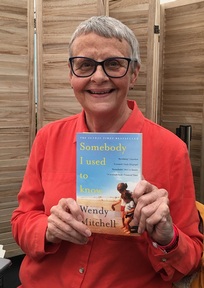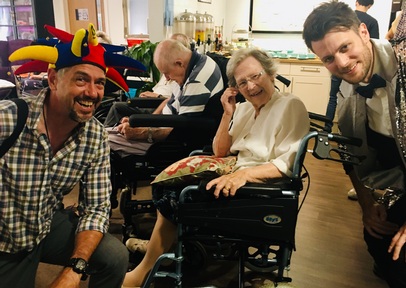Growing number of care homes using controversial doll therapy on people with dementia
Doll therapy is being used in a growing number of care homes, yet it is still seen as a controversial intervention despite its benefits.

The image of an older person cuddling and singing to a child's doll can seem strange and incongruous. Yet care homes have found older people with dementia enjoy cuddling the dolls and it stops them being distressed and agitated.
For doll therapy to work, therapists recommend using dolls that are as lifelike as possible.
Ruth Ablett, a holistic therapist, has been using cuddle therapy with dolls for over eight years. She trains other therapists in the technique and says: “Reborn doll therapy (reborn dolls resemble human babies as much as possible) has been used in recent times with great success in the treatment of Alzheimer and dementia patients around the world. It can have such a positive effect that the patient's psychotropic drug dependency can be reduced.
“At Ashcroft Care Home based in Chesterfield, they have reported that reborn doll therapy has cut the number of patients using psychotropic drugs from 92 per cent to 28 percent.”
It can be very difficult for relatives watching their mum or auntie cuddling an inanimate doll. Yet Ms Ablett says their perceptions will change once they see their “loved one smile with pleasure at holding something close to love again.”
Doll therapy alleviates agitation and distress
She claims: “The reborn dolls seem to alleviate the agitation or distress suffered by the dementia patient. They help to reduce withdrawal and help overcome communication difficulties between the carer and the patient.”
The manager of Park House Residential Home in Devon, where Ms Ablett offers cuddle therapy, has found the residents, particularly the women, seemed to believe the dolls really were babies and held them as though they were.
“They gained a lot of pleasure from cradling the dolls and there was an obvious look of contentment on our residents' faces as they rocked and loved the 'babies'. Some of our residents were very interested in how the 'babies' were dressed, because the clothes were quite different from the baby clothes that they would have dressed their own babies in over 60 years ago,” she says.
Rose Court Care Home in Manchester, has a reminiscence room with a nursery with empathy dolls – these are like cabbage patch dolls but they have weighted bottoms which makes people want to pat them. The care home has found the dolls have had a very positive effect on residents improving their “emotional wellbeing”.
It can be upsetting to see residents in infantilized state
For care homes wishing to use reborn dolls as therapy for people with dementia, it is important for staff to be able to feel confident explaining to the person’s relatives why the therapy is beneficial as it can be upsetting for relatives to see them in this infantilized state.

Four Seasons Healthcare, which uses doll therapy as part of its PEARL (Positively Enriching And Enhancing Residents' Lives) programme admits there has been opposition from both relatives and staff.
Caroline Baker, head of quality and dementia care at Four Seasons Healthcare, says: “On a few occasions we have had relatives question it and we always make sure we fully explain what doll therapy is to the relatives.”
Residents’ interactions with dolls need to be closely monitored
Care home staff need to monitor residents’ interactions with the dolls very carefully. Some care homes have found residents can get too attached to the dolls, putting them to sleep in their beds, for example, while they sleep in the chair. They have also led to arguments between residents.
Four Seasons Healthcare has found residents have become so attached to the dolls there have been tussles over them. It has even had to go as far as introducing baby high chairs into the dining halls so residents could feed their dolls while eating their meals.
There has not been much research into the impact of using doll therapy on people with dementia, but a study, ‘Using dolls to alter behaviour in patients with dementia’, by researchers at Newcastle General Hospital, revealed care staff voiced concerns initially, saying using the dolls was "babyish", "totally demeaning" and "patronising".
Afterwards, however, everyone said there were clear benefits and reported a calming effect, reduction in wandering, increased communication and improved speech.
Mishel Ingle, manager of Granby Rose Care Home in Harrogate, has found “some families have felt embarrassed by the fact that their relative used dolls or teddies at home and have also been comforted by the fact that we promote it and that it is OK for their relative to want to do this. We have helped them to realise why it is so important.”
Some of the Four Seasons staff refused to use the dolls at first as "they felt we were treating the residents like children, but we don't force the dolls on the residents. Some of the staff got quite militant and cross about it but once they saw it for themselves they changed their minds. I tend to put one on my knee and I ask residents if they would like to hold the doll. I also leave the dolls lying around so residents can just pick them up if they feel like it,” says Ms Baker.
Doll therapy triggers happy parenthood memories
There are various theories as to why doll therapy works. Some believe it brings back happy memories of parenthood and of being useful and needed. For some residents, doll therapy is very much a nurturing thing as it gives them a sense of meaning and purpose.

Interestingly, doll therapy also seems to work with people who have not had children. “People who haven't had children find it comforting as well. My first introduction to doll therapy was with a man who was really missing his wife. He took the doll and calmed down immediately and began talking to the doll,” reveals Ms Baker.
Carer Angela Whitlock, wrote about her experiences of doll therapy for people with dementia on the Alzheimer’s Society website.
Her mum has suffered with vascular dementia for about five years and it is getting progressively worse.
She read about doll therapy on the internet and went out and bought a reborn doll.
“I introduced the doll now named Billy to my Mum who treated it like a real life baby. I had to reassure her that it was mine and not hers as she became worried about having any responsibility. I didn't make her hold the doll but I laid it gently next to her on the sofa and I noticed she immediately put a cushion to the front of it as she would a real infant to make sure he didn't fall off.
“Gradually I shifted the little Billy doll so it laid its head on her knee and she sat there stroking its head and smiling.
“Eventually I let her hold the baby doll and she spent two or three hours cuddling it and talking to it. It was lovely to see her so happy. I took it with me when I left because I realised having to look after it would stress her.”
Ms Whitlock urges caution when introducing doll therapy, saying: “I find the doll gives her a lovely focus but you have to be careful that you only do things slowly and never force anyone to do anything. Let them decide they want to engage with it. And most importantly if it stresses them then immediately remove it and distract with something else.”
Whatever people’s views on doll therapy, whether they see it as unethical or highly beneficial, it looks set to become more and more popular in care homes, as with dementia on the increase, alternative therapies such as doll therapy are certainly more attractive than pharmalacogical interventions.
Latest Features News
 25-Nov-19
2019 Election: Boris Johnson leaves social care in 'too difficult box' but Labour vows to end 'crisis'
25-Nov-19
2019 Election: Boris Johnson leaves social care in 'too difficult box' but Labour vows to end 'crisis'
 18-Oct-19
Podcast: Wendy Mitchell and dementia: 'My biggest fear is not knowing who my daughters are'
18-Oct-19
Podcast: Wendy Mitchell and dementia: 'My biggest fear is not knowing who my daughters are'
 27-Sep-19
Exclusive: Care minister backs care workers' call for time off to grieve and attend funerals
27-Sep-19
Exclusive: Care minister backs care workers' call for time off to grieve and attend funerals
 19-Sep-19
Podcast: Gyles Brandreth says poetry helps ward off dementia
19-Sep-19
Podcast: Gyles Brandreth says poetry helps ward off dementia
 30-Aug-19
Edinburgh Fringe funnyman joins comics facing toughest audience at care home gig
30-Aug-19
Edinburgh Fringe funnyman joins comics facing toughest audience at care home gig